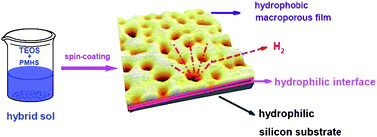Tuning pore size and hydrophobicity of macroporous hybrid silica films with high optical transmittance by a non-template route†
Abstract
Macroporous

* Corresponding authors
a
School of Physical and Chemical Sciences, Queensland University of Technology, Brisbane, QLD, Australia
E-mail:
mailto:hy.zhu@qut.edu.au
Fax: + 61 73138 1804
Tel: + 61 73138 1581
b
State Key Laboratory of Coal Conversion, Institute of Coal Chemistry, Chinese Academy of Sciences, Taiyuan, China
E-mail:
xuyao@sxicc.ac.cn
Fax: + 86 351 4041153
Tel: + 86 351 4049859
Macroporous

 Please wait while we load your content...
Something went wrong. Try again?
Please wait while we load your content...
Something went wrong. Try again?
D. Yang, Y. Xu, W. Xu, D. Wu, Y. Sun and H. Zhu, J. Mater. Chem., 2008, 18, 5557 DOI: 10.1039/B804967J
To request permission to reproduce material from this article, please go to the Copyright Clearance Center request page.
If you are an author contributing to an RSC publication, you do not need to request permission provided correct acknowledgement is given.
If you are the author of this article, you do not need to request permission to reproduce figures and diagrams provided correct acknowledgement is given. If you want to reproduce the whole article in a third-party publication (excluding your thesis/dissertation for which permission is not required) please go to the Copyright Clearance Center request page.
Read more about how to correctly acknowledge RSC content.
 Fetching data from CrossRef.
Fetching data from CrossRef.
This may take some time to load.
Loading related content
